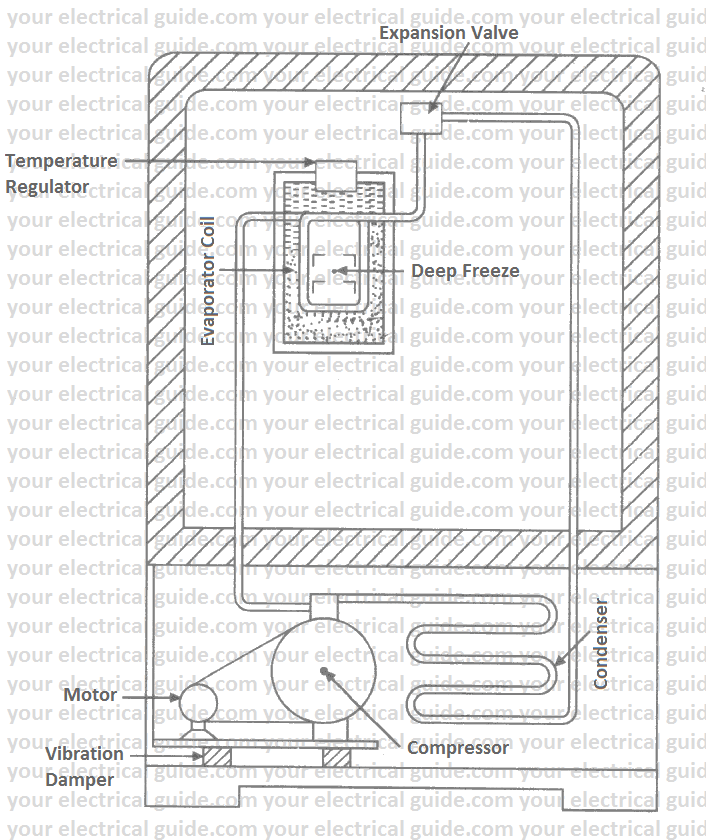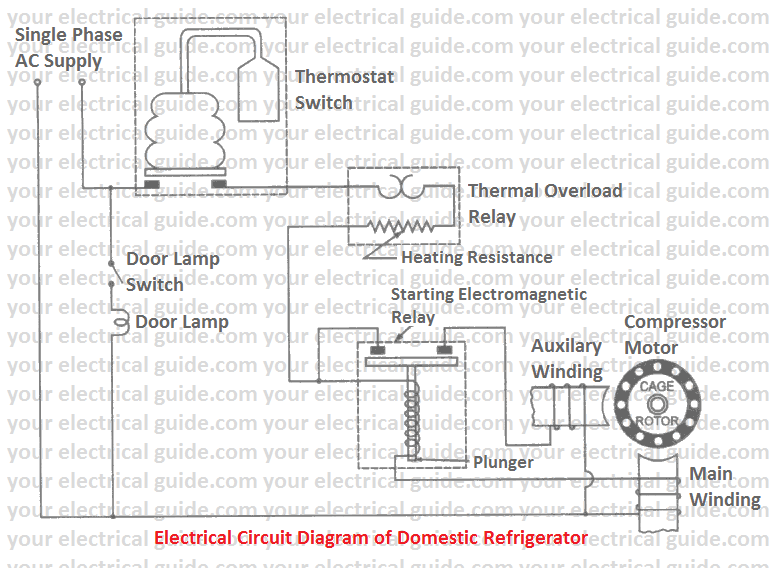Hi friends,
In this article, I am going to discuss the domestic refrigerator working principle and construction. You will find this article interesting and informative. So let us start.
The common type of domestic refrigerator has a cabinet shaped with compressor, the condenser and receiver fitted in their basement. The expansion valve and evaporator coils are exposed in the storage cabinet with the pipings, carrying liquid refrigerant passing through the body. Generally, methylene chloride, Freon-12, and Freon-11 are used as the refrigerants.
Refrigeration is not only provided with double-walled cabinet packed with materials having high thermal insulation such as fiberglass, cork or expanded rubber but also all around the inside of door flap soft rubber seal is used which makes the cabinet airtight.
Also the door is provided with automatic closing mechanism—door hinges are provided in such a way that door flap when left in open position automatically comes to closing position due to gravity and as it approaches closing position it is attracted by the magnetic strip fitted behind the sealing rubber ring and thus the door is closed with snap action.
All this is done to prevent leakage of atmospheric heat inside the refrigerator. The main precaution to be taken is that very hot things should not be put in the refrigerator if it is done it will quickly evaporate the refrigerant in evaporator coils producing a large vapor pressure increasing the duty of the compressor. It may damage the motor, which is short-time rated.
Domestic Refrigerator Working Principle
The heat of the items, to be cooled is carried to the evaporator coils by means of air trapped in the cabinet. The working fluid, known as a refrigerant, used in refrigerator readily evaporates and condenses or changes alternately between the vapor and liquid phases without leaving the refrigerator. The refrigerant keeps circulating from evaporator coil to condenser till compressor motor is connected to the supply.

During evaporation, it absorbs heat from items placed in the refrigerator and in condensing or cooling or liquefying it rejects heat outside the refrigerator. The heat absorbed from items placed in the refrigerator during evaporation is used as its latent heat for converting it from liquid to vapor. Thus a cooling effect is created in the working fluid. And this decreases the temperature inside the refrigerator.
When a predetermined value of the temperature is achieved inside the refrigerator, thermostat switch operates and disconnects the compressor motor from the electric supply. Further circulation of refrigerant and its cooling effect stops.
After some time, when the temperature increases and reaches up to a predetermined value, thermostat operates again and connects the compressor motor to the supply. And the cooling process starts again. This cycle is repeated continuously to maintain the temperature in a predetermined temperature range.
In this way, the refrigerant is circulated through the coils of the refrigerator to maintain the temperature in the required temperature range.
Electrical Circuit of a Refrigerator
The electrical circuit of a refrigerator is shown in Figure. The refrigerator is provided with a door push switch, which closes on the opening of the refrigerator and puts the lamp on. Split-phase single phase induction motor is used in the sealed compressor unit to run the compressor. Thermal overload release is provided to protect the motor from damage against the flow of over-current.

Thermostat switch is provided to control the temperature inside the refrigerator. The temperature inside the refrigerator can be adjusted using the temperature control screw. Greater the distance between contacts, the greater will be the temperature inside the refrigerator and vice versa. To protect the motor against under-voltage use of automatic voltage regulator is essential since, in case of fall in applied voltage, the motor will draw heavy current to develop the required torque and will become hot.
Vapor Compression System Parts
The refrigerant in this unit is circulated through the various components of the system with the help of a motor installed in the compressor unit where it undergoes a number of changes in its state or condition. Each cycle of operation consists of the four fundamental changes in the state of the refrigerant:
(i) expansion (ii) vaporization (iii) compression and (iv) condensation.
The vapor compression system of a domestic refrigerator consists of the following five essential parts:
Compressor: The low pressure and temperature vapor refrigerant from the evaporator is drawn into the compressor through the inlet or suction valve, where it is compressed to high pressure and temperature. The high pressure and temperature vapor refrigerant is discharged into the condenser through the delivery or discharge valve.
Condenser: The condenser or cooler consists of coils of pipe in which the high pressure and temperature vapor refrigerant is cooled and condensed. The refrigerant, while passing through the condenser, rejects its latent heat to the external surrounding air. Thus hot refrigerant vapor received from the compressor is converted into liquid form in the condenser.
Receiver: The condensed liquid refrigerant from the condenser is stored in a vessel, known as a receiver, from where it is supplied to the expansion valve or refrigerant control valve.
Expansion Valve or Throttle Valve: The function of this valve is to allow the liquid refrigerant under high pressure and temperature to pass at a controlled rate after reducing its pressure and temperature. Some of the liquid refrigerant evaporates as it passes through the expansion valve, but the greater portion is vaporized in the evaporator at the low pressure and temperature.
Evaporator: An evaporator consists of coils of pipe in which the liquid-vapor refrigerant at low pressure and temperature is evaporated and changed into vapor refrigerant at low pressure and temperature. During the evaporation process, the liquid-vapor refrigerant absorbs its latent heat of vaporization from the medium which is to be cooled (i.e. items placed in the refrigerator).
Thanks for reading about “domestic refrigerator working principle and construction”. Please like and share this article to support and encourage me.
Utilization of Electrical Energy| All Posts
- Direct | Indirect Resistance Heating
- Induction Heating | Ajax Wyatt Furnace
- Coreless Induction Furnace
- Electric Arc Furnace Working Principle
- Dielectric Heating Principle
- Electrical Resistance Welding
- Types of Electric Resistance Welding
- Describe the Electroplating Process
- Laser Beam Welding Process
- Electron Beam Welding Working Principle
- Domestic Refrigerator Working Principle
© www.yourelectricalguide.com/ electric circuit of refrigerator and working principle.